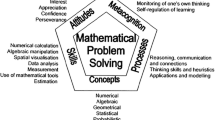Abstract
Curriculum, as a cultural and system-specific artifact, outlines mathematics teaching and learning activities in school education. Studies of curriculum and its changes are thus important to reveal the expectations, processes and outcomes of students’ school learning experiences that are situated in different cultural and system contexts. In this article, we aim to propose a framework that can help readers to develop a better understanding of curriculum practices and changes in China and/or the USA that have been reported and discussed in articles published in this themed issue. Going beyond the selected education systems, further studies of curriculum practices and changes are much needed to help ensure the success of educational reforms in the different cultural and system contexts.
Similar content being viewed by others
References
Fuson, K., & Li, Y. (2009). Cross-cultural issues in linguistic, visual-quantitative, and written-numeric supports for mathematical thinking. ZDM-The International Journal on Mathematics Education. In this themed issue.
Griffiths, H. B., & Howson, A. G. (1974). Mathematics: society and curricula. London: Cambridge University Press.
Grouws, D. (Ed.). (1992). Handbook of research on mathematics teaching and learning. New York: MacMillian.
Hirsch, C., & Reys, B. (2009). Mathematics curriculum: A vehicle for school improvement. ZDM-The International Journal on Mathematics Education. In this themed issue.
Kulm, G. (1999). Making sure that your mathematics curriculum meets standards. Mathematics Teaching in the Middle School, 4, 536–541.
Latterell, C. M. (2004). Math wars: A guide for parents and teachers. Westport, CT: Praeger.
Lester, F. K., Jr. (Ed.). (2007). Second handbook of research on mathematics teaching and learning. Charlotte, NC: Information Age Publishing.
Li, Y. (2000). A comparison of problems that follow selected content presentations in American and Chinese mathematics textbooks. Journal for Research in Mathematics Education, 31, 234–241.
Li, Y. (2007). Curriculum and culture: An exploratory examination of mathematics curriculum materials in their system and cultural contexts. The Mathematics Educator, 10(1), 21–38.
Li, Y., Chen, X., & An, S. (2009). Conceptualizing and organizing content for teaching and learning in selected Chinese, Japanese and US mathematics textbooks: The case of fraction division. ZDM-The International Journal on Mathematics Education. In this themed issue.
Li, Y., Chen, X., & Kulm, G. (2009). Mathematics teachers’ practices and thinking in lesson plan development: a case of teaching fraction division. ZDM-The International Journal on Mathematics Education. In this themed issue.
Li, Y., & Leung, F. K. S. (2009). Practices and changes in mathematics curriculum and teacher education in selected education systems in East Asia: What might we learn? In F. K. S. Leung, & Y. Li, (Eds.), Reforms and issues in school mathematics in East Asia—Pursuing excellence in mathematics curriculum and teacher education. Rotterdam, The Netherlands: Sense Publishers. (in press).
Li, Y., Zhang, J., & Ma, T. (2009). Approaches and practices in developing mathematics textbooks in China. ZDM-The International Journal on Mathematics Education. In this themed issue.
Liu, J., & Li, Y. (2009). Mathematics curriculum reform in the Chinese mainland: Changes and challenges. In F. K. S. Leung, & Y. Li, (Eds.), Reforms and issues in school mathematics in East Asia. Rotterdam, The Netherlands: Sense Publishers. (in press).
Lloyd, G. M. (2009). School mathematics curriculum materials for teachers’ learning: Future elementary teachers’ interactions with curriculum materials in a mathematics course in the United States. ZDM-The International Journal on Mathematics Education. In this themed issue.
National Council of Teachers of Mathematics. (1980). An agenda for action: Recommendations for school mathematics of the 1980s. Reston, VA: National Council of Teachers of Mathematics.
National Council of Teachers of Mathematics. (1989). Curriculum and Evaluation Standards for School Mathematics. Reston, VA: National Council of Teachers of Mathematics.
National Council of Teachers of Mathematics. (2000). Principles and Standards of School Mathematics. Reston, VA: National Council of Teachers of Mathematics.
Nie, B., Cai, J., & Moyer, J. C. (2009). How a standards-based mathematics curriculum differs from a traditional curriculum: With a focus on intended treatments of the ideas of variable. ZDM-The International Journal on Mathematics Education. In this themed issue.
Schmidt, W. H., McKnight, C. E., Valverde, G. A., Houang, R. T., & Wiley, D. E. (1997). Many visions, many aims: A cross-national investigation of curricular intentions in school mathematics (Vol. 1). Dordrecht, The Netherlands: Kluwer.
Senk, S. L., & Thompson, D. R. (Eds.). (2003). Standards-based school mathematics curricula: What are they? what do students learn? Mahwah. NJ: Erlbaum.
Silver, E. A. (2009). Cross-national comparisons of mathematics curriculum materials: What might we learn? ZDM-The International Journal on Mathematics Education. In this themed issue.
Stevenson, H. W., & Stigler, J. W. (1992). The learning gap: Why our schools are failing and what we can learn from Japanese and Chinese education. New York: Simon & Schuster.
Stigler, J. W., & Hiebert, J. (1999). The teaching gap: Best ideas from the world’s teachers for improving education in the classroom. New York: Simon & Schuster.
Wong, N. Y. (1998). In search of the “CHC” learner: Smarter, works harder or something more? Plenary lecture. In H. S. Park, Y. H. Choe, H. Shin, & S. H. Kim (Eds.). Proceedings of the ICMI-East Asia Regional Conference on Mathematical Education (Vol. 1, pp. 85–98).
Acknowledgments
We thank all the contributors who worked diligently to follow the timelines of preparation and publication. Our special thanks are due to all reviewers for reading the manuscript and providing valuable comments for improvements. We also thank Gabriele Kaiser, the journal editor-in-chief of ZDM, for her strong and consistent support and patience. Working with colleagues from different education systems has been a very rewarding experience and underscores the international flavor of ZDM.
Author information
Authors and Affiliations
Corresponding author
Rights and permissions
About this article
Cite this article
Kulm, G., Li, Y. Curriculum research to improve teaching and learning: national and cross-national studies. ZDM Mathematics Education 41, 709–715 (2009). https://doi.org/10.1007/s11858-009-0217-1
Accepted:
Published:
Issue Date:
DOI: https://doi.org/10.1007/s11858-009-0217-1




